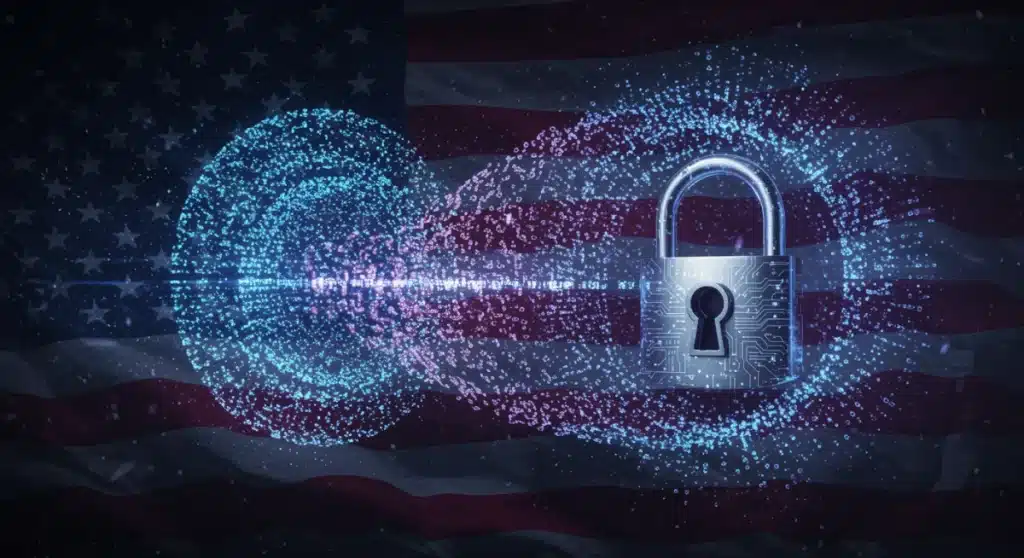Quantum-Resistant Encryption: US Standards Compared

The US is currently analyzing two key quantum-resistant encryption standards to safeguard critical data against the impending threat of quantum computing, shaping the future of global cybersecurity infrastructure.
The race to secure digital communications against powerful quantum computers is intensifying, and the US is at the forefront of this critical endeavor. As quantum computing advances, the need for robust, Quantum-Resistant Encryption US standards becomes paramount. This analysis delves into two leading candidates currently under consideration, examining their potential to redefine cybersecurity.
The Imminent Quantum Threat to Current Cryptography
The arrival of fault-tolerant quantum computers poses a significant threat to many of the cryptographic algorithms that currently secure our digital world. These powerful machines could, in theory, break widely used encryption schemes like RSA and ECC, compromising everything from financial transactions to national security secrets. The Department of Homeland Security (DHS) and other US agencies have consistently highlighted this as a top-tier national security concern, urging proactive measures.
Experts predict that a cryptographically relevant quantum computer (CRQC) could emerge within the next decade, rendering much of today’s encrypted data vulnerable. This isn’t a distant future problem; data encrypted today, if intercepted and stored, could be decrypted later by a CRQC. This ‘harvest now, decrypt later’ threat necessitates immediate action to transition to quantum-resistant solutions.
Understanding Shor’s and Grover’s Algorithms
- Shor’s Algorithm: This quantum algorithm can efficiently factor large numbers and solve discrete logarithm problems, directly threatening RSA and ECC. Its power fundamentally undermines the mathematical foundations of current public-key cryptography.
- Grover’s Algorithm: While less devastating than Shor’s, Grover’s algorithm can speed up unstructured database searches, including brute-force attacks on symmetric key ciphers (like AES) and hash functions. It effectively halves the security strength of these algorithms, requiring longer key lengths.
NIST’s Post-Quantum Cryptography Standardization Process
Recognizing the gravity of the quantum threat, the U.S. National Institute of Standards and Technology (NIST) launched a multi-year effort to standardize new, quantum-resistant cryptographic algorithms. This rigorous process began in 2016, soliciting proposals from cryptographers worldwide and subjecting them to extensive public scrutiny and cryptanalysis.
NIST’s goal is to identify algorithms that can withstand attacks from future quantum computers while also being practical for real-world implementation across various applications and devices. The standardization process involves multiple rounds of evaluation, narrowing down candidates based on security, performance, and efficiency criteria. This methodical approach ensures that the chosen standards are robust and reliable for decades to come.
Key Phases of NIST’s Selection
- Call for Proposals: Initial submission of algorithms from global research teams.
- Public Review and Analysis: Expert and public scrutiny to find weaknesses.
- Standardization: Final selection and publication of recommended algorithms.
As of recent developments, NIST has announced initial selections for standardization, marking a significant milestone. These chosen algorithms represent the culmination of years of research and collaboration, moving us closer to a quantum-safe cryptographic landscape. The ongoing process continues to refine these selections and explore additional candidates for different use cases.
Analyzing Standard 1: CRYSTALS-Kyber for Key Establishment
One of the primary selections from NIST for key-establishment algorithms is CRYSTALS-Kyber. This lattice-based cryptography candidate has emerged as a frontrunner due to its strong security foundations and promising performance characteristics. Key establishment is crucial for securely exchanging symmetric keys, which are then used for bulk data encryption.
Kyber’s security relies on the hardness of mathematical problems in lattices, specifically the Learning With Errors (LWE) problem and the Module-LWE problem. These problems are believed to be intractable even for quantum computers, making Kyber a strong contender for securing future communications. Its design allows for relatively small key sizes and efficient computations, which are vital for widespread adoption.
Performance Metrics and Security Profile
Benchmarking studies have consistently shown that Kyber offers a good balance between security and performance. Its operations are relatively fast, making it suitable for various applications, including Transport Layer Security (TLS) connections that underpin secure web browsing. The algorithm’s resistance to known classical and quantum attacks has been thoroughly vetted by the cryptographic community.
- Key Sizes: Generally smaller than other lattice-based candidates, optimizing for bandwidth.
- Computational Efficiency: Fast encryption and decryption operations, crucial for high-throughput systems.
- Attack Resistance: Strong theoretical backing against both classical and quantum algorithms.
The US government, through agencies like the National Security Agency (NSA), has expressed confidence in the security posture of lattice-based cryptography, further bolstering Kyber’s position as a preferred standard. Its adoption is expected to provide a robust layer of defense for critical infrastructure and sensitive data.
Analyzing Standard 2: CRYSTALS-Dilithium for Digital Signatures
Alongside Kyber, CRYSTALS-Dilithium has been selected by NIST as a primary standard for digital signatures. Digital signatures are fundamental for authenticating identities and ensuring data integrity, preventing tampering and impersonation. Dilithium, also a lattice-based algorithm, provides a quantum-resistant solution for these essential security functions.
Dilithium’s security, like Kyber’s, is rooted in the hardness of lattice problems, specifically the Short Integer Solution (SIS) and Module-SIS problems. These mathematical challenges are believed to be resistant to quantum attacks, making Dilithium an ideal choice for ensuring the authenticity of digital communications and software updates in a post-quantum world.

The algorithm is designed to produce compact signatures and support efficient verification processes, which are critical for applications ranging from secure boot processes to verifying software downloads. Its performance characteristics make it a viable replacement for current digital signature algorithms like RSA and ECDSA.
Advantages of Dilithium’s Design
- Signature Size: Generates relatively small signatures, reducing bandwidth overhead.
- Verification Speed: Fast verification times, essential for high-volume authentication.
- Strong Authentication: Ensures the origin and integrity of data, even against quantum adversaries.
The selection of Dilithium underscores the US’s commitment to securing the entire cryptographic ecosystem against quantum threats. Its robust design and performance make it a cornerstone for future digital trust, safeguarding everything from secure transactions to authenticated software deployments. The ongoing analysis continues to confirm its suitability for widespread implementation.
Comparison of Kyber and Dilithium: Roles and Synergies
While both CRYSTALS-Kyber and CRYSTALS-Dilithium are lattice-based and quantum-resistant, they serve distinct but complementary roles within the cryptographic landscape. Kyber is primarily a Key Encapsulation Mechanism (KEM), used for securely exchanging secret keys between parties. Dilithium, on the other hand, is a digital signature algorithm, used for verifying the authenticity and integrity of data and identities.
Together, these two standards form a powerful combination for building comprehensive quantum-resistant security protocols. A typical secure communication session would use Kyber to establish a shared secret key, which is then used by a symmetric cipher (like AES) for encrypting the actual data. Dilithium would be used to digitally sign messages or identities, ensuring that the communicating parties are legitimate and that the data hasn’t been tampered with.
Key Differentiators and Complementary Strengths
- Kyber (KEM): Focuses on confidentiality by enabling secure key exchange.
- Dilithium (Digital Signature): Focuses on authenticity and integrity, verifying origin and preventing tampering.
- Synergy: Together, they provide a full suite of quantum-resistant security primitives for modern protocols.
The US’s strategic selection of both a KEM and a digital signature scheme from the same lattice-based family simplifies implementation and reduces potential interoperability issues. This integrated approach ensures a more seamless transition to a post-quantum cryptographic infrastructure, providing end-to-end security against future quantum threats. Both algorithms have undergone extensive analysis and have proven resilient.
Implementation Challenges and Future Outlook
The transition to quantum-resistant cryptography, while essential, presents significant implementation challenges. Organizations globally, particularly within the US, must begin planning for this migration now. This involves inventorying existing cryptographic assets, identifying systems reliant on vulnerable algorithms, and developing strategies for integrating new quantum-resistant standards.
One major challenge is the ‘crypto-agility’ of existing systems – the ability to easily upgrade or swap out cryptographic algorithms. Many legacy systems were not designed with such flexibility in mind, making the transition complex and potentially costly. Furthermore, ensuring interoperability between new and old systems during the transition period will be crucial to avoid disruptions.
Roadmap for Quantum Migration
The US government, through agencies like NIST and the Cybersecurity and Infrastructure Security Agency (CISA), is providing guidance and resources to aid this transition. This includes developing migration roadmaps, publishing best practices, and encouraging collaboration between government, industry, and academia. The goal is to make the transition as smooth and secure as possible, minimizing vulnerabilities during the critical period.
- Inventory and Assessment: Identify all cryptographic instances and their vulnerabilities.
- Pilot Programs: Test new algorithms in isolated environments to understand performance and integration.
- Phased Rollout: Gradually implement quantum-resistant cryptography across systems, prioritizing critical assets.
The future outlook involves continued research and development in post-quantum cryptography, including exploring alternative algorithm families and refining existing ones. The journey to a fully quantum-safe world is ongoing, but the standardization of Kyber and Dilithium marks a monumental step forward in securing our digital future against emerging threats. The cybersecurity landscape is evolving rapidly, and proactive measures are key.
| Key Standard | Primary Function & Impact |
|---|---|
| CRYSTALS-Kyber | Selected by NIST for Key Encapsulation (KEM), securing key exchange against quantum attacks, vital for confidentiality. |
| CRYSTALS-Dilithium | NIST’s choice for Digital Signatures, ensuring data authenticity and integrity in a post-quantum environment. |
| Quantum Threat | Quantum computers pose an imminent risk to current public-key cryptography, necessitating new, resistant standards. |
| NIST’s Role | Leading the global standardization process for post-quantum cryptographic algorithms through rigorous evaluation. |
Frequently Asked Questions About Quantum-Resistant Encryption
Quantum-resistant encryption refers to cryptographic algorithms designed to withstand attacks from powerful quantum computers. These algorithms use mathematical problems that are believed to be intractable even for future quantum machines, safeguarding digital communications and data for the long term.
The US is prioritizing these standards due to the ‘harvest now, decrypt later’ threat, where encrypted data intercepted today could be decrypted by future quantum computers. Proactive standardization is crucial to secure critical infrastructure and sensitive information before quantum threats become a reality.
CRYSTALS-Kyber is a Key Encapsulation Mechanism (KEM) for securely exchanging secret keys, ensuring confidentiality. CRYSTALS-Dilithium is a digital signature algorithm used for verifying authenticity and integrity of data and identities. They serve complementary roles in building a complete security posture.
Key challenges include the complexity of migrating legacy systems, ensuring ‘crypto-agility’ for seamless upgrades, and managing interoperability during the transition period. Organizations must inventory existing cryptographic assets and plan phased rollouts to minimize disruption and vulnerabilities.
NIST has made initial selections, and the standardization process is ongoing with plans for full implementation over the next few years. The transition timeline will vary by sector and organization, but widespread adoption is expected to accelerate as quantum computing capabilities advance.
What Happens Next
The US’s proactive steps in standardizing quantum-resistant encryption, particularly with CRYSTALS-Kyber and Dilithium, mark a pivotal moment in cybersecurity. The coming months will see continued development of implementation guidelines and greater emphasis on migration strategies for both government and private sectors. Organizations are urged to begin assessing their cryptographic posture now, preparing for the inevitable shift. This transition is not merely an IT upgrade but a fundamental re-architecture of trust in our digital world, safeguarding against the most sophisticated threats on the horizon.





